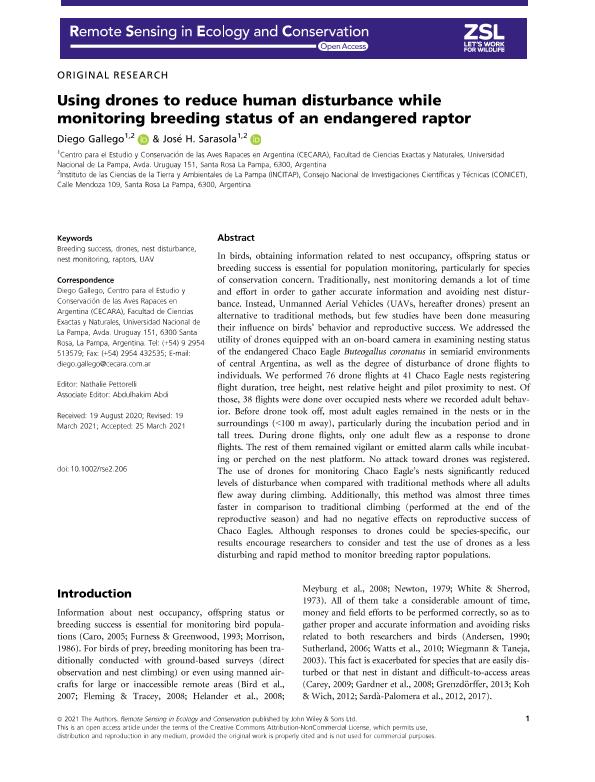Mostrar el registro sencillo del ítem
dc.contributor.author
Gallego García, Diego

dc.contributor.author
Sarasola, José Hernán

dc.date.available
2023-01-05T10:24:16Z
dc.date.issued
2021-05
dc.identifier.citation
Gallego García, Diego; Sarasola, José Hernán; Using drones to reduce human disturbance while monitoring breeding status of an endangered raptor; John Wiley & Sons; Remote Sensing in Ecology and Conservation; 7; 3; 5-2021; 550-561
dc.identifier.issn
2056-3485
dc.identifier.uri
http://hdl.handle.net/11336/183419
dc.description.abstract
In birds, obtaining information related to nest occupancy, offspring status or breeding success is essential for population monitoring, particularly for species of conservation concern. Traditionally, nest monitoring demands a lot of time and effort in order to gather accurate information and avoiding nest disturbance. Instead, Unmanned Aerial Vehicles (UAVs, hereafter drones) present an alternative to traditional methods, but few studies have been done measuring their influence on birds’ behavior and reproductive success. We addressed the utility of drones equipped with an on-board camera in examining nesting status of the endangered Chaco Eagle Buteogallus coronatus in semiarid environments of central Argentina, as well as the degree of disturbance of drone flights to individuals. We performed 76 drone flights at 41 Chaco Eagle nests registering flight duration, tree height, nest relative height and pilot proximity to nest. Of those, 38 flights were done over occupied nests where we recorded adult behavior. Before drone took off, most adult eagles remained in the nests or in the surroundings (<100 m away), particularly during the incubation period and in tall trees. During drone flights, only one adult flew as a response to drone flights. The rest of them remained vigilant or emitted alarm calls while incubating or perched on the nest platform. No attack toward drones was registered. The use of drones for monitoring Chaco Eagle’s nests significantly reduced levels of disturbance when compared with traditional methods where all adults flew away during climbing. Additionally, this method was almost three times faster in comparison to traditional climbing (performed at the end of the reproductive season) and had no negative effects on reproductive success of Chaco Eagles. Although responses to drones could be species-specific, our results encourage researchers to consider and test the use of drones as a less disturbing and rapid method to monitor breeding raptor populations.
dc.format
application/pdf
dc.language.iso
eng
dc.publisher
John Wiley & Sons

dc.rights
info:eu-repo/semantics/openAccess
dc.rights.uri
https://creativecommons.org/licenses/by-nc/2.5/ar/
dc.subject
BREEDING SUCCESS
dc.subject
DRONES
dc.subject
NEST DISTURBANCE
dc.subject
NEST MONITORING
dc.subject
RAPTORS
dc.subject
UAV
dc.subject.classification
Conservación de la Biodiversidad

dc.subject.classification
Ciencias Biológicas

dc.subject.classification
CIENCIAS NATURALES Y EXACTAS

dc.subject.classification
Ecología

dc.subject.classification
Ciencias Biológicas

dc.subject.classification
CIENCIAS NATURALES Y EXACTAS

dc.subject.classification
Zoología, Ornitología, Entomología, Etología

dc.subject.classification
Ciencias Biológicas

dc.subject.classification
CIENCIAS NATURALES Y EXACTAS

dc.title
Using drones to reduce human disturbance while monitoring breeding status of an endangered raptor
dc.type
info:eu-repo/semantics/article
dc.type
info:ar-repo/semantics/artículo
dc.type
info:eu-repo/semantics/publishedVersion
dc.date.updated
2021-12-13T19:23:04Z
dc.journal.volume
7
dc.journal.number
3
dc.journal.pagination
550-561
dc.journal.pais
Reino Unido

dc.description.fil
Fil: Gallego García, Diego. Universidad Nacional de La Pampa. Facultad de Ciencia Exactas y Naturales. Departamento de Recursos Naturales. Centro para el Estudio y Conservación de Aves Rapaces; Argentina. Consejo Nacional de Investigaciones Científicas y Técnicas. Instituto de Ciencias de la Tierra y Ambientales de La Pampa. Universidad Nacional de La Pampa. Facultad de Ciencias Exactas y Naturales. Instituto de Ciencias de la Tierra y Ambientales de La Pampa; Argentina
dc.description.fil
Fil: Sarasola, José Hernán. Consejo Nacional de Investigaciones Científicas y Técnicas. Instituto de Ciencias de la Tierra y Ambientales de La Pampa. Universidad Nacional de La Pampa. Facultad de Ciencias Exactas y Naturales. Instituto de Ciencias de la Tierra y Ambientales de La Pampa; Argentina. Universidad Nacional de La Pampa. Facultad de Ciencia Exactas y Naturales. Departamento de Recursos Naturales. Centro para el Estudio y Conservación de Aves Rapaces; Argentina
dc.journal.title
Remote Sensing in Ecology and Conservation
dc.relation.alternativeid
info:eu-repo/semantics/altIdentifier/url/https://zslpublications.onlinelibrary.wiley.com/doi/10.1002/rse2.206
dc.relation.alternativeid
info:eu-repo/semantics/altIdentifier/doi/http://dx.doi.org/10.1002/rse2.206
Archivos asociados
